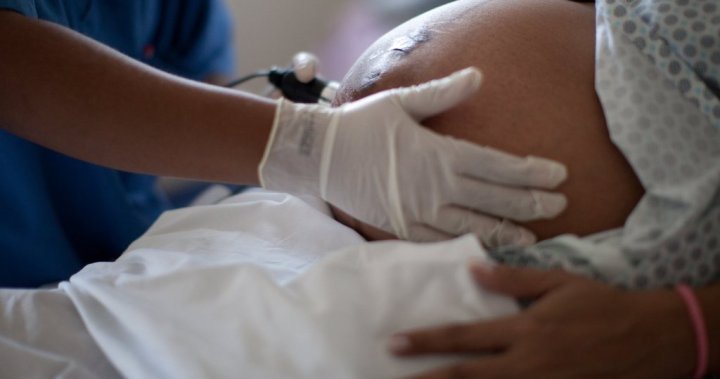Uncategorized
OB/GYN patient complaints up 29% over previous year: Ontario’s patient ombudsman

New data shows more people are filing complaints about obstetrical and gynecological care in Ontario, with insensitivity, poor communication and lack of trauma awareness among the most common grievances.
Ontario’s Patient Ombudsman Craig Thompson says his office received 168 complaints between April 2024 and March 2025, compared to 130 over the same period the previous year — a 29 per cent increase.
Complainants also detailed experiencing a lack of responsive care to factors such as history of sexual assault, pregnancy complications, miscarriages, and difficult births.
Many complaints were related to pregnancy, childbirth and postnatal care provided in hospitals, he said. There’s also been an increase in complaints regarding services at community surgical and diagnostic centres that do ultrasounds, X-rays and surgical procedures.
Complaints are filed online, by email, fax or mail, and then reviewed by the ombudsman, who engages with both parties to reach a resolution.
National data from the Canadian Medical Protective Association suggests patient complaints across medical disciplines are on the rise, with more than 4,045 in 2020, up from 3,379 in 2016. They said many complaints showed communication was an underlying issue.
The Ontario ombudsman’s data will be published later this year in an annual report on the overall number and themes of health-system complaints, but Thompson shared the OB/GYN numbers with The Canadian Press in the wake of an investigation published last week that included several patients alleging neglectful care going back almost a decade by the same Toronto doctor.
The patients described traumatic experiences while under the care of OB/GYN Dr. Esther Park, with some alleging they were not adequately informed about certain procedures performed at her clinic and the hospital she worked at for 25 years.
Dr. Park stopped practising medicine in April. Attempts to reach her for comment were unsuccessful.
In the ombudsman’s last annual report released in March, the number of obstetrical and gynecological-related complaints in the province was described as an “emerging concern” that Thompson said he would continue to monitor.
While Thompson said the way women’s health is delivered in Ontario has been an issue for many years, he said what’s new is the number of grievances about obstetrics and gynecology, and the nature of the complaints.
“We are in that role of a bit of the canary in the coal mine. We identify early signals of a problem,” he said, explaining that annual reports are shared with the province’s ministries of health, long-term care, and relevant health agencies.
The patient ombudsman’s role was created by the provincial government in 2016 to help resolve complaints and conduct investigations on issues of public interest.

Get weekly health news
Receive the latest medical news and health information delivered to you every Sunday.
Thompson calls his office the “last resort” for patients who are not satisfied with a hospital’s response to a complaint, and who need help reaching a resolution. But he also tries to pinpoint if a broader issue needs to be investigated and what can be done.
Thompson said he tries to determine: “Where’s the breakdown? Is this a breakdown in policy? Is this a breakdown in education or training of our team? Is this a breakdown in practice? Is the practice that we’ve adopted not meeting the mark?”
He would not disclose if he’s conducting a broader investigation of obstetrical and gynecological care complaints. His last report included two pages on the practice, identifying “broader organizational issues, including a lack of trauma-informed care approaches that, if addressed, could improve the experiences of patients and their families.”
Dr. Heather Millar, an obstetrician and gynecologist at Women’s College Hospital and Mount Sinai Hospital in Toronto, says a trauma-informed approach begins with an awareness of how common painful childhood memories, sexual assaults and triggering medical encounters are. It also includes strategies to avoid traumatizing or retraumatizing a patient.
She said she first came across the method in 2015.
“I was working with a physician at the time who used trauma-informed care principles and I realized that this was something that we should all be doing and that really should be implemented across our specialty,” Millar said.
The premise is to treat each patient as though they have a trauma history, for instance asking permission before touching them and covering their bodies during an exam to facilitate an environment that feels safe.
Since then, Millar has been helping integrate the approach at hospitals, including within Mount Sinai’s obstetric emergency training, and she teaches trauma-informed care to residents at the University of Toronto.
She’s also working on national guidelines with the Society of Obstetricians and Gynaecologists of Canada (SOGC) to formally implement this approach as a standard of care.
“We’re much more conscious now of how common trauma is in the general population … and also how the encounters and procedures in our specialty can be traumatic for people,” she said, referencing vaginal exams that can feel invasive, and emergencies during deliveries, which may trigger painful memories.
Dr. Glenn Posner, vice chair of education for the department of obstetrics and gynecology at the University of Ottawa, said when he was a resident more than 20 years ago, trauma-informed care was not talked about. But now, he sees residents bring this sensitive approach to their patients, for instance asking for permission multiple times before an exam, or showing them how a speculum feels on their leg before using it.
But the stressful demands of the job and sheer volume of patients can at times hinder sensitive communication, and can translate into body language that patients will pick up on, he said.
“Having a conversation with somebody with your hand on the door knob is perceived as you’re rushing them. But you can spend the same amount of time or even less if you come in, pull up a chair, sit down.”
Similarly, Millar said there are small changes that can make patients feel more in control, such as raising the head of a hospital bed so that the physician can make eye-contact with them throughout an exam.
In response to an email from The Canadian Press containing the ombudsman’s new data, the ministry of health said it expects every hospital and health-care partner to uphold the highest standard of patient care. They referenced existing patient safety legislation and regulation, but did not say what they would do about the increase in obstetrical and gynecological complaints.
“One complaint about the safety of care is too many,” a spokesperson for the ministry of health said in a statement.
The SOGC said it would not comment on the data since it has not seen the full report.
The head of an advocacy group that speaks out on behalf of patients says she’s seen similar reports for years without any investment in changes.
“I am not surprised that there are more complaints that are coming in this particular area of practice,” said Kathleen Finlay, chief executive officer of the Center for Patient Protection.
Finlay, who has worked as a patient advocate for almost 20 years, said she often hears OB/GYN patients say, “They didn’t listen to me. I had a lot of concerns and I felt I was just being rushed through the process. My questions weren’t being answered.”
She said not enough is being done at the regulatory level to make changes to improve patient experience.
“There are many issues that are, from a woman’s perspective, very traumatic and so much of it is about not being treated with the respect that they deserve.”
Uncategorized
Blue Jays reinstate Gimenez from injured list

TORONTO – The Toronto Blue Jays reinstated second baseman Andres Gimenez from the 10-day injured list Tuesday and designated infielder Buddy Kennedy for assignment.
Gimenez, a three-time Gold Glove award winner, missed five weeks with a left ankle sprain.
Related Videos
The moves were announced shortly before the Blue Jays opened a three-game series against the visiting Chicago Cubs.
Entering play Tuesday night, Gimenez had five homers, 23 RBIs and a .218 average.

Get daily National news
Get the day’s top news, political, economic, and current affairs headlines, delivered to your inbox once a day.
Kennedy had one hit in two games for the Blue Jays. He also played four games for the Philadelphia Phillies earlier this season.
This report by The Canadian Press was first published Aug. 12, 2025.
© 2025 The Canadian Press
Uncategorized
Man dead, another in custody after stabbing in Toronto’s east end


Around 2:30 p.m., Toronto police said they were called to the area of Woodbine and Duvernet avenues for reports someone had been stabbed inside a neighbouring home.
Source link
Uncategorized
Jays’ Shapiro says he wants to remain with team

TORONTO – Blue Jays president Mark Shapiro declined to comment on contract extension talks Tuesday but said he wants to remain with the club and that team ownership has been “reciprocal in that desire.”
Shapiro, who also serves as chief executive officer, is in the final year of his contract.
“When I think about alternatives, I’ve never been a grass is greener guy,” he said in a pre-game availability. “Twenty-four years in one place in Cleveland and 10 years here now.
Related Videos
“So it’s the appreciation for what I have and the people that I get to work with every day, the city that I work in and the country that I live in, those things are drivers for me to remain here.”
Shapiro, 58, joined the club in 2015 and signed a five-year extension in January 2021.

Get daily National news
Get the day’s top news, political, economic, and current affairs headlines, delivered to your inbox once a day.
He took questions from reporters for about 20 minutes in a rare in-season media session. Shapiro was asked directly whether there had been discussions with team owner Rogers Communications on a new deal.
“Sure, yeah, I mean I think (it’s) not appropriate for me to comment beyond the fact that what I just said is I want to remain here,” Shapiro said. “And I can also say that both (Rogers executive chair) Edward (Rogers) and (Rogers president/CEO) Tony (Staffieri) have been reciprocal in that desire.”
It has been a worst-to-first campaign for Canada’s lone Major League Baseball team. The Blue Jays finished last in the American League East division standings last season but have enjoyed a stellar season in 2025.
Toronto entered Tuesday night’s game against the visiting Chicago Cubs with the best record in the AL at 69-50.
This report by The Canadian Press was first published Aug. 12, 2025.
© 2025 The Canadian Press
-

 Uncategorized2 months ago
Uncategorized2 months agoAccording to Dior Couture, this taboo fashion accessory is back
-

 Uncategorized2 months ago
Uncategorized2 months agoThese ’90s fashion trends are making a comeback in 2017
-

 Uncategorized2 months ago
Uncategorized2 months agoThe old and New Edition cast comes together to perform
-

 Uncategorized2 months ago
Uncategorized2 months agoUber and Lyft are finally available in all of New York State
-

 Uncategorized2 months ago
Uncategorized2 months agoNew Season 8 Walking Dead trailer flashes forward in time
-

 Uncategorized2 months ago
Uncategorized2 months agoMeet Superman’s grandfather in new trailer for Krypton
-

 Uncategorized2 months ago
Uncategorized2 months ago6 Stunning new co-working spaces around the globe
-

 Uncategorized2 months ago
Uncategorized2 months agoThe final 6 ‘Game of Thrones’ episodes might feel like a full season







